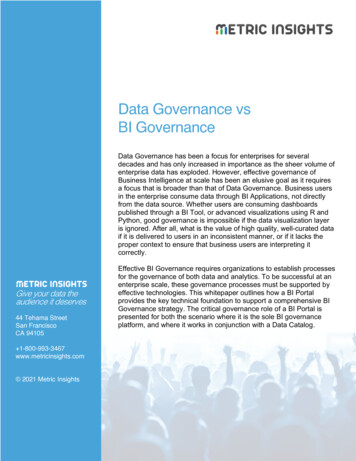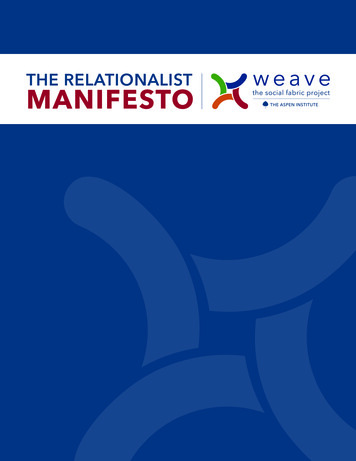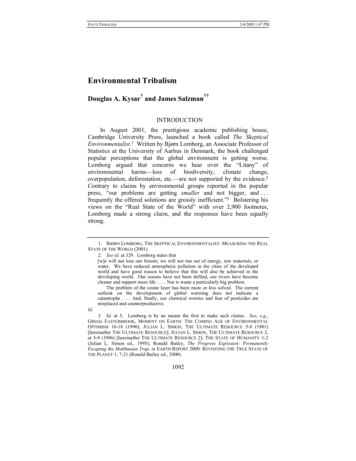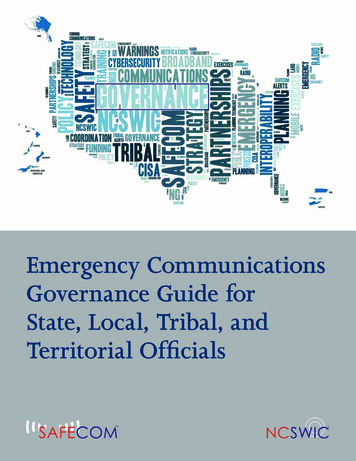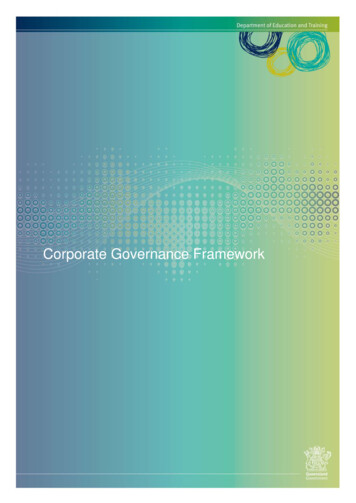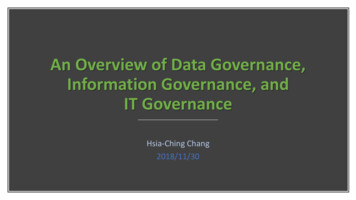
Transcription
TRIBALISM, GOVERNANCE ANDDEVELOPMENTSEPTEMBER 27, 2010This publication was produced for the United States Agency for International Development with supportfrom the United States Institute of Peace. This report was edited by Phyllis Dininio, Jennifer Murtazshvili,and Lynn Carter of Management Systems International and Mary Hope Schwoebel of the United StatesInstitute of Peace. It draws material from two workshops and research conducted for this project byJefferson Gray, Elham Manea, Chris Mason, Ken Menkhaus, Jennifer Murtazashvili, and Mary HopeSchwoebel. The authors’ views expressed in this publication do not necessarily reflect the views of theUnited States Agency for International Development or the United States Government.
Tribalism, Governance and DevelopmentWorking PaperManagement Systems InternationalCorporate Offices600 Water Street, SWWashington, DC 20024Contracted under DFD-I-20-04-00228-00AME DG Peace and Security Task Order, #20DISCLAIMERThe author’s views expressed in this publication do not necessarily reflect the views of the United StatesAgency for International Development or the United States Government.TRIBALISM, GOVERNANCE AND DEVELOPMENTi
CONTENTSEXECUTIVE SUMMARY. iiiI. INTRODUCTION . 1II. COMMONALITIES ACROSS COUNTRIES . 2III. VILLAGE LEVEL . 7IV. URBAN LEVEL . 13V. REGIONAL LEVEL . 18VI. NATIONAL LEVEL . 21VI. JUSTICE AND RECONCILIATION . 25VII. POLICY MODELS FOR DEALING WITH TRIBES. 30VII. TENTATIVE RECOMMENDATIONS . 37BIBLIOGRAPHY . 41TRIBALISM, GOVERNANCE AND DEVELOPMENTii
EXECUTIVE SUMMARYDevelopment assistance has faced many challenges and achieved limited impact in heavilytribalized, Muslim societies. This paper suggests ways that development assistance can bettersupport effective governance and dampen conflict in these societies. Our principal focus is onthree highly tribalized countries that are facing notable governance challenges and high levelsof conflict: Afghanistan, Somalia, and Yemen. We examine the role of tribes in governance at thevillage, urban, regional, and national level in each country to identify how tribes factor intogovernance problems or possible solutions.In all three countries, tribes are most active and easily mobilized as political, social, andeconomic entities at the village level. That is where the development community must be mostacutely tuned into tribal dynamics. In urban areas, state authority is more prominent and oftenusurps tribal ties, but with notable exceptions. At the regional and national level, commonalitiesacross the cases falter. Tribal or clan influence is strong at the regional and national level inSomalia and Yemen, but less so in Afghanistan. The research also points to competition overjurisdiction among three justice and conflict resolution systems—customary tribal law, Islamic orshari’a law, and the legal-rational system of the state—as a fundamental governance problem ineach of the three countries.This research suggests a number of tentative strategic and programmatic recommendations.These include:Work with existing structures. Given the instability and fragility confronting thesesocieties, it is important to maintain the sources of authority, dispute resolution, and securitythat work rather than creating alternative structures that have little legitimacy in local contexts.Setting up parallel organizations may consume resources that are better used elsewhere, andmay also contribute to instability if they erode the ability of village elders to maintain order andadminister justice.Focus at the district level in Afghanistan. In Afghanistan, development assistancehas focused on villages and established community development councils to distributeresources. However, Afghans need formal governance and intervention to help build the state atthe margins of communities where tribal or customary forms of self-organization are leasteffective.Involve traditional authorities in aid programs. Traditional authorities have akeen understanding of local dynamics and needs, and play a role in resolving disputes that mayarise from aid programs, such as contracts and rents. These leaders have legitimacy. Donorsshould consult with them through the life of a project -- not just at the beginning -- and shouldnot seek to undermine them.Do not alter the balance of power between tribes. Development must beconflict-sensitive. New resources can and sometimes do provoke conflict, especially if they are perceivedTRIBALISM, GOVERNANCE AND DEVELOPMENTiii
as benefiting some groups more than others. The distribution of development resources must thereforebe equitable across tribes as well as regions, districts, and sub-districts.Examine assumptions about state reach. In Afghanistan, extending the reach ofcentral government could be one cause of the expansion in the insurgency, not its cure.Particularly if the state is corrupt, weak, and ineffective, a limited government may be a betterapproach to stability.Support business. The business community has been an important avenue for improvedclan relations in Somalia. This has required businesspeople to seek out partners across clan lines.Fostering business helps create jobs and dampen conflict as business leaders have an incentiveto work with other clans. This approach is unlikely to have traction in Yemen, however, due tothe creation of a new class of crony shaykh businessmen, who have near monopolies orpreferential access to the state.Do not undermine customary law. Customary law is what works in these countries.Its norms are understood, and it has legitimacy. Governments need to maintain or at least strivenot to undermine what exists in order to have some form of functioning justice. The formaljustice system is often corrupt, inaccessible, unfair, costly and slow, and is not likely to replacetraditional dispute resolution mechanisms anytime soon. The donor community should notsupport formal systems as a total replacement for traditional ones.Do not provide funding for traditional conflict resolution mechanisms.Financial incentives for participation or cooperation with international organizations orgovernments undercut the legitimacy of traditional leaders, who generally work withoutcompensation for the good of the community and to enhance their personal and familialreputation and influence. Providing payments for their services threatens to undermine theirlegitimacy because they are then suspected of making decisions that are based on thosefinancial incentives. Reasonable stipends to cover basic expenses for participation in events suchas dialogues and training are acceptable as long as they are provided with transparency andaccountability.Foster discussion of human rights among customary authorities.Dialogue on customary practices that are discriminatory or abuse rights (especially genderrelated practices) may help to change attitudes. Efforts to improve traditional dispute resolutionsystems have borne fruit in some Muslim societies such as Bangladesh.Clarify the jurisdiction between state and traditional justice. One of themost effective ways to strengthen both the state justice sector and traditional conflict resolutionmechanisms is to expand opportunities for communication between them. This wouldsignificantly enhance their ability to negotiate their respective jurisdictions.Support traditional authority at the national level as a transitionalstrategy. The role of customary authority in Somaliland can serve as a possible transitionalTRIBALISM, GOVERNANCE AND DEVELOPMENTiv
strategy for countries emerging from state failure or civil war. Clan authorities can have manydrawbacks, but they are a known quantity among their communities and generally enjoylegitimacy as leaders. Their primary role traditionally has been as conflict mediators. This canmatter greatly in a context of high levels of communal distrust following civil war. Their formalrole can help build trust and confidence in the short-term. Or as a long-term governance strategy. Traditional authorities can complementmodern formal government with the prime example being a House of Elders, such as the Guurtiin Somaliland, which can prevent escalation of and solve political conflicts in government.Limit foreign expectations for help in combating terrorism. As a source ofcombating terrorism, Somali clans have both potential and limits. Clans have excellent capacity to gatherinformation about activities and movements in their clan home territory, but they are susceptible topenetration by al-Shabaab and vulnerable to al-Shabaab assassinations.TRIBALISM, GOVERNANCE AND DEVELOPMENTv
I. INTRODUCTIONInternational donors’ efforts to build stable states, strengthen governance systems, and mitigateconflict have foundered in the heavily tribalized and fragmented societies of the Muslim MiddleEast, South Asia and Horn of Africa. From Afghanistan to Yemen, Somalia, and beyond, tribalvalues and allegiances have weakened states, undermined formal governance institutions, andfueled conflict. Tribes in these states are locked in ambivalent and uneasy relationships withtheir respective states: they constitute rival, conflicting, and often overlapping structures ofpolitical authority that are not easily integrated into the state.1 They are capable of blocking andoften do block the state’s centralizing tendencies. At the same time, states may function less aslegal-rational entities and more as an expression of particular interests. Elaborate patronagenetworks and gross corruption are hallmarks of states functioning in these severely fragmentedsocieties. Ruling coalitions are inherently unstable and membership can shift rapidly; thedistribution of patronage is key to maintaining some kind of stability. Those outside thepatronage networks have good reason to resist state penetration.Because states in these environments do not have a monopoly on violence, they may sharepower with and allocate significant government largesse to locally powerful families or tribes inorder to maintain the peace and their own power. Yet there are often too many groups toaccommodate; there is seldom enough largesse to go around. Inequitable distribution changesthe local balance of power between competing tribes or clans and thus produces conflict.Development assistance programming has faced many challenges and achieved limited impactin these states with strongly tribalized cultures. Due to their geostrategic importance and theirlinks with local and transnational Salafi jihadist terrorism, a suspension or reduction of assistancein the face of suboptimal programming results is not possible. US national interests demand asearch for more effective governance and development assistance models. This paper suggestshow development assistance can be better structured to support effective governance anddampen conflict in these societies. Our principal focus is on three countries with sociallyfragmented, fractious, and highly tribalized societies that are facing notable governancechallenges and high levels of conflict: Afghanistan, Somalia, and Yemen.We examine the role of tribes in governance at the village, urban, regional, and national level ineach country to identify how tribes factor into governance problems or possible solutions. Weacknowledge that there are four interpretations of the long-term significance of informal localgovernance arrangements (see textbox on Interpreting the Significance). We identify somegeneral principles that are applicable to other countries as well as some that are specific to thecase studies.1A good basic primer is still Philip S. Khoury and Joseph Kostiner, eds., Tribes and State Formation in the MiddleEast, Berkeley, CA: University of California Press, 1990.TRIBALISM, GOVERNANCE AND DEVELOPMENT1
II. COMMONALITIES ACROSS COUNTRIESTribal forms and characteristics vary, but Afghanistan, Somalia and Yemen have several featuresin common. First, the three societies are characterized by tribal structures that are acephalous(headless), and as a result, fairly egalitarian in terms of tribal leadership. In such societies, kinshipand patrilineal descent are the basis for political organization and allegiance. Tribes are thencomposed of nested segments or lineages with those at the lowest levels having the closestrelations and the easiest time organizing collective action. While some tribes are very large,organizing collective action at higher levels is infrequent. It is not unusual for segments tomaintain hostile relations with neighbors, and alliances with neighbors’ neighbors.In such tribal societies, an egalitarian ethos prevails—the principle of equality among tribes andindividual adult males is deeply held. According to tribal codes, there is a commitment topersonal autonomy and leadership operates by consent and not generally by inheritance.Leaders often have limited power over followers; they operate by persuasion and establishcredibility through mediation skills.TRIBALISM, GOVERNANCE AND DEVELOPMENT2
INTERPRETING THE SIGNIFICANCE OF INFORMAL GOVERNANCE ORDERSWhether one has a normative preference for or against tribes as a possible source of authority to dealwith the challenges of conflict management, state-building, and security, most analysts agree that tribesplay a visible governance role in failed states. Where they disagree is over their interpretation of thelong-term significance of informal local governance arrangements. These differing interpretations fallinto four broad categories.Customary authorities and informal governance are of no significance. Informal governance and securityarrangements, according to this argument, reflect short-term coping mechanisms that will evaporate assoon as the central government is strengthened. Most state-building programs operate on thisassumption, and as a result devote little attention to mapping and understanding informal governance.Since local governance systems are seen to be of little consequence, this approach is not undulyconcerned about adhering to a “do not harm” principle as it promotes state revival.Tribe-based informal governance is actively harmful. Some observers worry that communities in somefailed states have adapted too well, drawing heavily on tribes and customary law to cope. In the process,they have reduced their incentives to support a revived state. Moreover, stakeholders in the informalgovernance systems will feel threatened by and will resist state-building. From this vantage point,informal governance arrangements form a dangerous source of potential spoilers to state-building, evenas they enshrine illiberal and tribal forms of rule of law. They are, from this perspective, a step backward.Weak central governments often (though not always) view local non-state actors in this vein, seeing themas potential rivals and rejecting external discussions about engaging them directly.Tribe-based authority is a transitional source of security and governance during the long period of staterevival or state formation. State-building takes many years, and it is unreasonable and unwise to expectthat local communities and the international community will be willing to tolerate extremely high levelsof security threats and “ungoverned space” in the interim. Tribe-based authority is a potential bridge, akey element of a strategy to deal with the specific security and governance problems during the longtransitional period of state revival. Tribe-based representation is also essential in building trust andpolitical “rules of the game” during post-conflict transitions. As formal state authorities graduallystrengthen and gain legitimacy, they will overlap with and then replace these informal polities.Somaliland’s evolution from clan-based to multi-party democracy is cited as an example of how clan canbe a vital part of a transition and confidence-building strategy.Source: Ken Menkhaus.Although tribal leadership is decentralized and diffuse, tribal identities can still be mobilized bycharismatic leaders. It is often the case, however, that those individuals who are able to mobilizetribes into cohesive political movements gain positions in strictly non-tribal organizations. Suchleaders emerge as heads of political parties, business groups, or armed factions. Onceestablished in such positions, they are able to mobilize others in their kinship group. The rise ofsuch leaders is often idiosyncratic and has little to do with the nature of the tribes themselves,but instead reflects the entrepreneurial capacity of a single individual. For example, Mullah Omarhas been able to mobilize many of his fellow Hotak Ghilzai Pashtuns behind the cause of theTaliban. He is able to do this not because of his position within a tribe, but because he gainedprominence in a political movement outside the tribe. Once in this position, he was able to usepatronage and other rewards to mobilize fellow kin in pursuit of his political objectives.Although these groups have no natural hereditary leaders, leadership within tribes often doesemerge among a class of elders or higher status families, who accede to positions ofprominence due to their ability to honestly and fairly broker disputes. In most cases, these eldersare men. While all men have the right to involve themselves in tribal affairs, in practice, eldersTRIBALISM, GOVERNANCE AND DEVELOPMENT3
tend to speak on behalf of the extended families that are embedded in tribal structures. As aresult, women and youth tend to be unrepresented in formal tribal procedures. This does notmean that women are unrepresented. Male elders speak on behalf of the interest of their familyat gatherings of other tribal representatives.The societies examined here are also governed by tribal codes. These codes are based in customand are not written down. The nature of such codes varies significantly within each society,although may follow general principles such as equality of each tribe or the importance ofmaintaining honor. In Afghanistan, the code of the Pashtunwali governs Pashtun tribal life, ‘urfgoverns tribal conduct in Yemen, and xeer on specific issues functions as a customary codeamong Somali clans. Rulings are made by consensus, not by majoritarian-based procedures.Reaching consensus on a particular case takes time. Agreements are negotiated over the courseof several days, if not weeks, or even monthsAll three societies are predominantly Muslim. While tribes may be associated with different sectsor schools of Shi’a or Sunni Islam, tribes themselves derive from family relations and geography.As such their legitimacy does not flow from religious tenets, but instead from the power offamilies and blood relations. In all three societies, there is often significant contradictionbetween Islamic law and customary or tribal law. In some cases, however, tribal law is derived inpart from Islamic principles. Notions of collective responsibility for the bad behavior of memberspertain, which provides a mechanism to ensure the good behavior of members within a tribalsegment. Strong concepts of honor, revenge and blood feud incline these societies to significantviolence. Large numbers of males typically engage in or are prepared for organized violence asthere is no separation between “military” and “civil” society. They are formidable fighters and inthese regions, which have long been awash in arms, they are well-equipped ones.The three countries, which these tribes inhabit, are characterized by difficult terrain, comprisedmostly of desert and mountains that limit the ability of families to generate surplus (with thepartial exception of Yemen, whose oil has secured it a quarter century of some surplus). Difficultterrain has not only presented challenges for colonial powers and other outsiders who havesought to influence or rule these societies, but has also presented a serious challenge for theleaders of these countries as they have sought to extend the writ of the state into thecountryside. In two of the countries, the more mountainous and arid terrain tends to correspondwith the more tribalized parts of each country: Pashtun areas in the south and east ofAfghanistan, and the north in Yemen.These cases also have in common weak central governments that are entwined in a deepstruggle with a religion-based insurgency. With the exception of Yemen, where there is somehistory of confederating, tribes in these countries have generally only united in a politicalmovement under the influence of a charismatic religious-political leader. Thus, Islam has playedan important role in establishing an overarching identity that can be mobilized for politicalpurposes that can supersede the narrower tribal loyalty.Tribes remain the most resilient sources of collective action in rural areas among both sedentaryagriculturalists and nomadic pastoralists. Traditional authorities regulate village life, controlTRIBALISM, GOVERNANCE AND DEVELOPMENT4
access to land, and maintain security through customary conflict resolution mechanisms. Whileone must be careful to generalize when speaking about tribes, it is safe to say that they play amore prominent role in directing village life, as tribal codes of conduct are most often applied inthese contexts, and where there is often less competition from the institutions and norms of thestate. In urban areas, tribes may play a role (Somalia), but generally the writ of the state is lesscontested given the multiplicity of groups sharing geographic space.Finally, in all three of these cases, tribes play a far from predictable role in regional or nationallevels. At these higher levels of association, institutions of the state (albeit very weak institutions)are the source of contestation and competition. Tribes may at times mobilize under charismaticleaders, religious figures, or political groups for control of the state apparatus. They mayinfluence politics and shape formal institutions, as in Somaliland, but do not directly control thestate.Before discussing the role of tribes at the rural, urban, regional or national levels in each of thesecases, it is important to first define what we mean by tribe in each of the three cases consideredin this study.Tribe Definition: AfghanistanPashtun society has been dubbed the world’s largest tribal society. Such a description ismisleading, however, as Pashtun tribes are so segmentary that the tribes and sub-tribes do noteasily aggregate into cohesive social or political entities beyond the local level. A fundamentaldifficulty with tribes as a form of political or social organization at the regional or national levelis that Pashtun tribal affiliations do not have a bottom-up or a top-down hierarchical structure.There are five major descent groups in Pashtun tribes: the Durrani, Ghilzai, Ghurghusht, andKarlanri (known as the "Hill Tribes"), and the Sarbani. A sixth group, the Kuchi, is ethnicallycomposed of Ghilzai and Durrani, but are nomadic and quite distinct socially and culturally fromthe sedentary groups. For most of its history, Afghanistan has been led by members of theDurrani confederation. The royal family was of Durrani descent; so too is President Hamid Karzai.In recent years, the most serious challenges to Durrani rule have been fueled by largely Ghilzailed opposition movements. Most of the leaders of the People’s Democratic Party of Afghanistan(PDPA) which toppled centuries of Durrani rule were largely Ghilzai. Notably, many leaders ofthe early Taliban movement were also Ghilzai (including Mullah Omar). In recent years, it isdifficult to characterize the Taliban insurgency as a Ghilzai movement as it contains significantmembers from all tribal confederations.The 400 major Pashtun tribes are sub-divided into roughly 3,000 clans, or khels. Theseaffiliations lie at the heart of understanding many of the dynamics of local politics in the southand east of Afghanistan where a vast majority of the Pashtun society within Afghanistan reside.Beneath this level of segmentation are the 30,000 to 40,000 extended families, or kahols. Thekahol is the primary level of Pashtun social organization, and the largest social group to whichthe vast majority of Pashtuns ever perceive allegiance and identity. Only on rare occasions, suchTRIBALISM, GOVERNANCE AND DEVELOPMENT5
as war or a major land dispute, does the khel-level identity ever coalesce. This is unlikely tohappen even once in a Pashtun's lifetime.While generalizations can be made at the khel level, and even at the descent group level (i.e.,Durrani vs. Ghilzai conflicts), it is at the kahol level that the questions posed by this project needto be answered. In terms of extent and geography, the kahols predominate at the district andsub-district levels, and are important factors in the social groupings of the roughly 80 percent ofPashtun who are rural residents.Tribe Definition: SomaliaSomalis are all of the same tribe. In fact, Somalia was held up as Africa’s only genuine nationstate during the African independence movements of the 1960s, because its population was ofone tribe, one religion, and one language. Within this tribe, most scholars identify six majorSomali clan families believed to have sprung from a legendary Arabian ancester: Darod, Hawiye,Isaq, Dir, Rahanweyn and Digil. The first four are primarily camel, sheep, and goat herdingpastoralists. They have traditionally occupied the semi-arid far-southern, central, and northernregions of the country and Djibouti. The latter two are primarily agropastoralists, who practicethe rain-fed cultivation of sorghum, maize, and cowpeas, and who herd cattle in addition tocamels, sheep, and goats. The Rahanweyn and Digil have inhabited the fertile, interriverineregions between the Juba and Shebelle Rivers, from western Ethiopia to the southern Somalicoast.Since independence, political and economic power and resources have alternated between twoof these clan families—the Darod and the Hawiye. The Darod clan family consists of a number ofclans, the main ones being the Mijerteen, Marehan, Ogaden, Dolbahante, and Warsengeli. TheMijerteen clan controlled the parliamentary democracy from independence in 1960 until thecoup of 1969. From the coup of 1969 until the collapse of the state in 1991, the militarygovernment was controlled by the Marehan clan. Power in post-civil war Mogadishu, however,rested mainly in the hands of the Hawiye clan, which also consists of a number of clans,including the Abgal, Habergidir, Hawadle, and Murusade. While al-Shabaab, the violent Islamistextremist group, began as a Hawiye, particularly Habergider, movement, it has since becomedominated by other clans, and the Habergider have turned against it, refashioning themselvesinto anti-Wahabist “Sufis”.Clan affiliations were the basis for survival, security, and identity in traditional Somali society andcontinue to be so today for most Somalis. Clan also continues to provide the moral frameworkthat shapes Somalis’ attitudes and behaviors. It is a moral responsibility to assist one’s clanmembers, whether politically, economically, or logistically. Therefore, what westerners wouldconsider immoral practices in the context of governance—corruption, nepotism, and even thedeployment of violence—are moral practices in the Somali context. In this setting, theappropriation of resources for the promotion of clan interests and the well-being of clanmembers is both logical and ethical.TRIBALISM, GOVERNANCE AND DEVELOPMENT6
Tribe Definition: YemenWhile a unified state and a common Muslim identity in theory unite Yemen, the country isdivided along sectarian, tribal, regional, ideological, and economic lines. The north is dominatedby Zaydi Shia Muslims (sometimes called a sixth school of Sunni Islam), while the south and thecoastal parts of the country are dominated by Sunni (Shafi’i) Muslims. There are many tribalgroupings in Yemen; the most relevant are the Hashid and Bakil confederations in the arid,northern steppe. Fertile lands in the south encouraged farming, which helped to dissolve to acertain degree the tribal roots of these groups and led to the creation of semi-feudal separateentities in the region. Moreover, access to ports created opportunities for economic growth inthe southern part of the country. Consequently, most of the interior has remained quite isolatedand underdeveloped in comparison to the south.In the Yemeni context, tribes can be understood as kin-ordered, self-protection, and welfareassociations that may agglomerate into confederations of political significance. Extendedfamilies are not necessarily the same thing as a tribe. Extended families exist nearly everywherein Yemen, but only some extended families manifest themselves for political purposes todemand things from the state or from other tribes. In some places, like the highland steppes ofcentral- northern Yemen, tribal confederations have always existed. These central highland tribeshave generally maintained a higher degree
acutely tuned into tribal dynamics. In urban areas, state authority is more prominent and often usurps tribal ties, but with notable exceptions. At the regional and national level, commonalities across the cases falter. Tribal or clan influence is strong at the regional and national level in Somalia and Yemen, but less so in Afghanistan.
